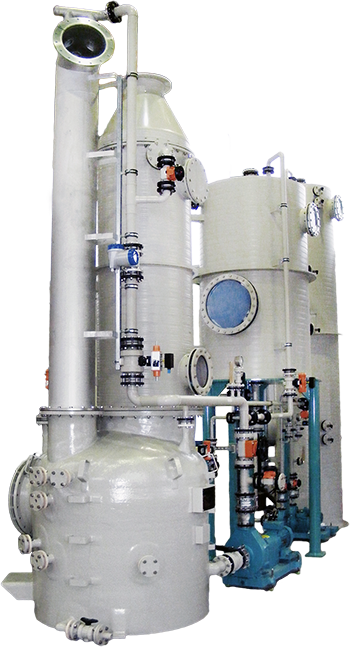Jet scrubbers
Jet scrubbers are used for the basic processes cooling, absorption, dedusting and conveying.
The gas enters the jet scrubber from the side. The motive fluid acts as a scrubbing medium and direct current injects it to the gas and into the scrubber. The gas is accelerated due to the impulse exchange with the motive fluid. This results in conveying flow, enabling an increase in the gas pressure. Depending on the design of the plant, this rise in pressure means that the internal flow resistance of the plant and the resistance in adjacent pipes can be overcome. Therefore, the jet scrubber replaces a mechanical ventilator in many cases.
The level of power transmission manifests itself in a jet scrubber’s pressure gain. Because the scrubbing medium is sprayed through nozzles, the cylindrical section of the scrubber is filled with a full cone and reaches the large phase interface area between the gas and the liquid which is required for the basic operations.

Advantages at a glance
- simple designs
- little maintenance required
- high levels of reliability and availability
- no fire risk in the scrubber
- a combination of gas conveying with dedusting and absorption
Applications
The self-priming jet scrubber is superb for:
- conveying gas without mechanical ventilators
- direct gas cooling (quenching)
- physical and chemical absorption of harmful substances (SO2, Cl2, HCI, NH3, HF, H2S, etc.)
- removing dust with particles over 3 μm in size
- recovering substances from gases
Further information
A typical Körting jet scrubbing plant consists of:
- jet scrubber
- separation tank
- swirl droplet separator (DTA)
These components all play a part in the process as a whole. The jet scrubber conveys, absorbs, dedusts and cools the gas with the aid of the scrubbing medium. The scrubbed gas and the liquid phase are separated from one another in the separation tank. At the same time the tank acts as a buffer before the scrubbing liquid is distributed.
The downstream swirl droplet separator is used to separate the fine droplets caught in the gas flow. Depending on the engineering requirement, further components can also be added. Environmental regulations are complied with and substances can be recovered from gases by using single or multi-stage jet scrubbers, also in combination with packed towers.

The Körting jet scrubbing plants are supplied as follows:
- as standard versions of DN 80 to DN 1000 for gas flows of 60 to 26000 m³/h, also in combination with packed towers
- customised solutions for gas flows of 60 to 100000 m³/h, in single or multi-stage designs
Depending on the application, combinations can be used to fulfil special conditions and requirements. Solutions with good track records are also available for special cases, such as gas flows of up to 300000 m³/h or gas temperatures over 1000 °C.
- carbon steel, stainless steel
- steel with coatings: rubber, PVDF, PTFE, Halar, etc.
- plastics: GFK, PP, PVC, PVDF reinforced and non-reinforced
- special materials
The Vent Gas Treating System is a complete unit which includes jet scrubber, separation tank, packed tower and swirl droplet separator and is fully mounted in a steel structure.
The objective of the system shown is to remove hydrochloric acid, chlorine and sulphur dioxides from a hot processing flow. The plant is designed for gas inlet temperatures of 530 °C. By using caustic soda (10% NaOH) and sodium hydrogen sulphite (20% NaHSO3) as scrubbing fluids all absorbed components can be removed from the waste gas. As required by statute (German TA Luft regulation) the gas emissions are scrubbed and can be released into the atmosphere.

Downloads

Time to talk.
Individual solutions are created through consistent dialogue with our customers - which is why we focus on being as close to our customers as possible.

